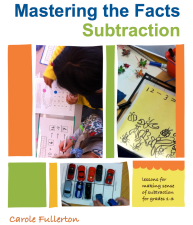Another New Resource! Multiplicative Thinking – From Skip Counting to Algebra (Grades 3 to 8)
 For those of you about to return to another school year, welcome back!
For those of you about to return to another school year, welcome back!
I am truly excited to announce the release of my newest teacher resource book: Multiplicative Thinking: From Skip Counting to Algebra (Grades 3 to 8). This book is designed for teachers of the intermediate grades and is focused on the teaching and learning of multiplication. This resource addresses multiplication deeply — what it means to multiply, when to use multiplication in problem-solving situations, as well as how to manipulate whole number, fractional and decimal factors using strategies like the distributive property.
Lessons on skip counting, patterns in the multiples, factoring, and on prime and composite numbers are included in this 220 page teacher resource. Algebraic thinking is explored as well, from T-charts and input-output machines to solving equations, from graphing linear relations and extrapolation to finding the slope of a line. Students engage with visuals and real-world problems involving proportionality, rates, discounts and taxes to build their understanding of multiplicative thinking and see its very real application to their everyday lives.
Each of the 40 lessons features a connection to prior knowledge, whole class and small group explorations of the Big Math Ideas, guided conversations about the mathematics with key vocabulary, opportunities for meaningful practice, tasks for consolidation and customized assessment tools. Skill building lessons are interspersed throughout the book, ensuring students recall and continue to practice the essential skills needed to apply multiplicative ideas.
And of course literature links and games for practice are — as always — included!
Multiplicative Thinking: From Skip Counting to Algebra (Grades 3 to 8) is available for $40 + $10 expedited shipping. To order, click here or on the link at the right. From there you can also order other titles, including Mastering the Facts: Multiplication, a resource dedicated to the teaching and mastery of the critically important multiplication facts. It’s a perfect complement to this new volume and one that can be used in advance — or concurrently — to build a solid foundation.
Thank you for your support. All the best for a remarkable school year!
Carole
Why Multiplicative Thinking?
Multiplicative thinking plays an enormous role in elementary and middle school mathematics. So much bigger than simply knowing the facts — a critically important aspect — the ability to think multiplicatively is essential for success with almost every other mathematical concept, from ratio and proportionality to algebra. It is the operation most often used in “real life” to make sense of large quantities, of taxes and discounts, of income per hour and kilometres travelled. It’s the operation we use when we figure out how much paint or carpet to buy or what a tank of gas is going to cost; when we convert currency for a holiday away or sort out how much to tip on a meal. No matter where we look, multiplicative situations abound. We can’t spend too much time on the teaching and learning of these critical concepts!
In writing this resource, I have attempted to introduce multiplicative thinking — both the operation itself and the bigger concept of multiplicative reasoning — in a sense-making way. Through stories, models, pictures and words, students are introduced to the idea of multiplication as “groups of” and as “rows of”. Problems are posed to support learners in connecting what they know about patterns in the multiples to proportional situations. The associative and distributive properties are introduced and applied. Algebraic concepts — input and output machines, graphing and exploring the rate of change in linear relations — round out the topic and provide a preview for multiplicative reasoning at the middle and high-school levels.
Great games for developing fluency
Hello all! I wanted to upload a couple of my new favourite games for developing fluency with the facts.
Once a strategy for recalling the facts has been learned, these games will help students to apply those strategies more fluently. It takes time and practice to master the facts – practice with the strategies and then practice using the strategies to recall the facts themselves… We all know the facts are critical to success with math. How we master them matters too.
So, first is the game from BEAM called Add Nines. It depends on knowing the strategy of “compensation”. Compensation is an algebraic idea, in which we “take from one number and give to the other”. This strategy works because in every case we make a ten (or another round number).
Think of it like this:
If we add 9 and 7, then we can take 1 from the 7 and give it to the nine, to make 10 and 6. And ten and 6 is easy… 16!
This game invites students to practice “taking one from one addend and giving it to the 9 to make ten and some more…” While this SOUNDS tricky, if you imagine the following images of 9 and 7, it’s pretty evident:

The next game is for mastering the 2 x facts and the 4 x facts. It’s my own (adapted from another BEAM game) but with numbers accessible to students learning these facts in 4th and 5th grade. It’s called Double or Double-Double. The goal of the game is to practice the strategy of doubling (multiplying by 2) or “double-doubling” (multiplying by four).
Think of it this way. Double 6 is 12. Double 12 is 24. So that means that double-double 6 is 24… Mathematically speaking, it’s the same as 2 x (2 x6) or 4 x 6. The idea of “double-doubling” works for all numbers, too. I like to call it the Tim Horton’s strategy. :o)
I hope these games prove fun for you and your children… More than that, I hope they will help your kids to truly master these important facts!
Enjoy!
Carole
Mastering the Multiplication Facts – Strategic thinking…
 Hello to my colleagues in Coquitlam!
Hello to my colleagues in Coquitlam!
I wanted to share a template for a set of multiplication flash cards that are set up to be used by strategy. You’ll notice that in the attached multiplication fact cards file, each of the fact families appears in a different colour, to bring to mind the particular strategy that matches the fact. The hope here is that, like with Cuisenaire rods. the related colours will help to call to mind the relationships between the facts themselves. I recommend that students cut apart the cards and practice the facts by strategy, one at a time, as they learn and then recall them.
Here’s the idea…
Consider the “multiply by 5” facts. For these, we think of the 10’s facts, and then find half of it…
7 x 5… think 7 x 10 ÷ 2 or 70 ÷ 2
Because the 5 facts are related to the 10’s fact, their colours are likewise related in the flash cards – yellow for the 5’s and orange for the 10’s.
The 9’s are another fact related to ten. For the “multiply by 9’s” we think multiply by ten and subtract one group.
7 x 9… think 7 x (10 – 1) or 7 x 10 – 7
The 9 fact cards are in a related colour as well – red for the 9’s and orange for the tens.
In the same vein, the 2’s are green, the fours are dark green (since they are double twos or the “double-doubles”) and the 3’s are blue. All are related colours, and each family uses the 2’s in some way. For three, we think double and add one set, like so:
7 x 3…. think 7 x (2 + 1) or 7 x 2 + 7
As for the remaining colours, the 1’s facts are all in white to highlight their simplicity (What you see is what you get!!), the square numbers are purple (for no other reason than purple is my favourite colour and the squares are my favourite facts!) and the last three remaining facts – the most complex ones to master strategically – are in pink.
The facts that are the reverse of all of these (the commutative or “flip-around” facts) have been left uncoloured in the bottom left hand corner of the virtual chart, since if we master the coloured ones – and practice them both forwards and backwards – we will likewise have mastered these ones. You might choose to print and cut them out, or not.
Hope this proves helpful…
Carole







